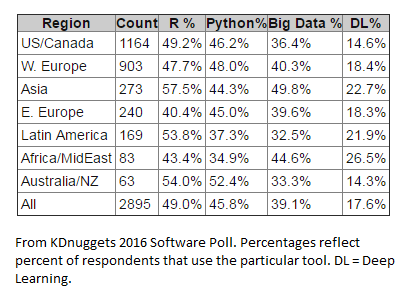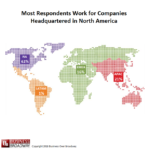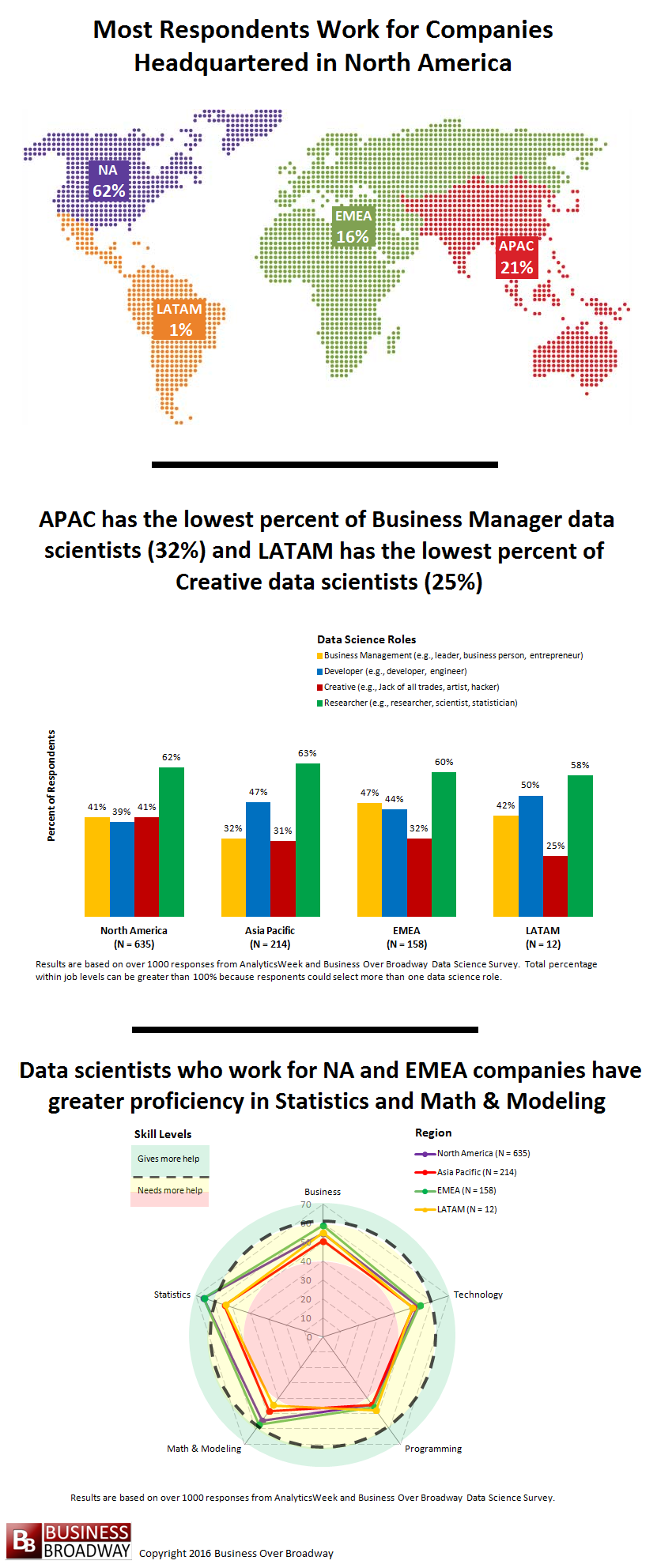The AnalyticsWeek and Business Over Broadway Data Science Survey survey revealed regional differences in data science roles, proficiency in data science skills and satisfaction with work outcomes. APAC has the lowest percent of Business Manager data scientists (32%). LATAM has the lowest percent of Creative data scientists (25%). North America has the lowest percent of Developer data scientists (39%). Data scientists from North America and EMEA have greater proficiency in Statistics and Math & Modeling skills compared to their counterparts in other regions. There were no difference among regions on satisfaction with work outcomes.

Figure 1. Adoption rates of analytics tools across regions. From KDnuggets 2016 Software Poll.
Big Data and data science adoption is occurring throughout the world. While all regions are growing their data science capabilities, KDnuggets found strong regional differences in the use of analytics tools among data professionals (see Figure 1). Their results showed that NA shows lower adoption of Big Data tools (36%) compared to EMEA and APAC countries (~43%). LATAM and APAC countries show higher adoption of the statistical analysis tool, R (54%), compared to EMEA and NA countries (~46%). The current analysis will extend this research to better understand regional differences in data science roles and expertise. Do adoption rates for these tools match the skills needed to use those tools?
We asked over 1000 data professionals about themselves and what they do. We captured their proficiency across three broad data science skills: Business, Technology, Math & Modelling, Programming and Statistics. We also asked about the roles that these data scientists play: Business management, Developer, Creative and Researcher. Finally, we asked them about their satisfaction with the outcomes of projects on which they work.
A majority of the respondents work for companies headquartered in North America (62%) and APAC (21%) (see top of Figure 2).
Data Science Roles Across Regions
There were a few notable differences across regions with respect to the types of data scientists they have (see middle of Figure 2). Results showed that APAC has the lowest percent of Business Manager data scientists (32%) while EMEA has the most (47%). LATAM has the lowest percent of Creative data scientists (25%) while North America had the most (41%). There were no other statistically significant differences across regions for the other two data science roles (i.e., Researchers and Developers).
Proficiency in Data Science Skills Across Regions
Next, I looked at proficiency in skills across the different regions (see bottom of Figure 2). Of the five skills assessed, we only found two skills that varied significantly over regions. In general, data scientists from NA and EMEA had greater proficiency (on a scale from 0 to 100) in Statistics (~66) and Math & Modeling (~56) compared to data scientists from LATAM and APAC (~54 for Statistics and ~46 for Math & Modeling).
Satisfaction with Outcomes of Analytics Projects Across Regions
There was no statistically significant difference in satisfaction with work outcomes across regions. Satisfaction ratings were about 7.0 for each region (on a scale from 0 – Extremely dissatisfied to 10 – Extremely satisfied).
Summary
Survey results revealed a few interesting data science differences across regions.
Data scientists who work for companies headquartered in NA and EMEA reported greater proficiency in Statistics and Math & Modeling skills compared to the other two regions (also, these differences held even when we only compared Research data scientists across regions). It’s interesting to note that, even though data scientists from LATAM and APAC had significantly lower proficiency in Statistics and Math, the KDnuggets survey found a higher adoption rate of R (statistics program) for LATAM and APAC data scientists; despite the higher adoption rates in these regions, they may not be getting the most value from R due to sub-par skill proficiency (proficiency below 60).
Our prior research found a strong relationship between skill proficiency and satisfaction with work outcomes; data scientists with higher proficiency in data skills (especially Statistics and Math) were happier with the outcome of their analytics projects. However, in the current analysis at the regional level, we did not find this relationship. Data scientists from all regions reported the same level of satisfaction with their work despite differences in Statistics and Math skills proficiency.
There is no doubt that the field of Big Data and data science is growing across the world. While data scientists are key to extracting insights and value from their data, we know that a team of data scientists with complementary skills outperform their counterparts who work alone. It appears that companies headquartered in NA and EMEA may be in a better position to extract insights from their data given that their data scientists are more proficient in Statistics and Math, the language of data. A better understanding of the possible reasons (e.g., skill proficiency, analytics tools used, data science methods/practices) behind the regional differences can help international companies find the right mix of data scientists and help recruiters understand the pain points of some regions.
Article originally appeared on CustomerThink.





 Beyond the Ultimate Question
Beyond the Ultimate Question Measuring Customer Satisfaction and Loyalty (3rd Ed.)
Measuring Customer Satisfaction and Loyalty (3rd Ed.)
Comments are closed.